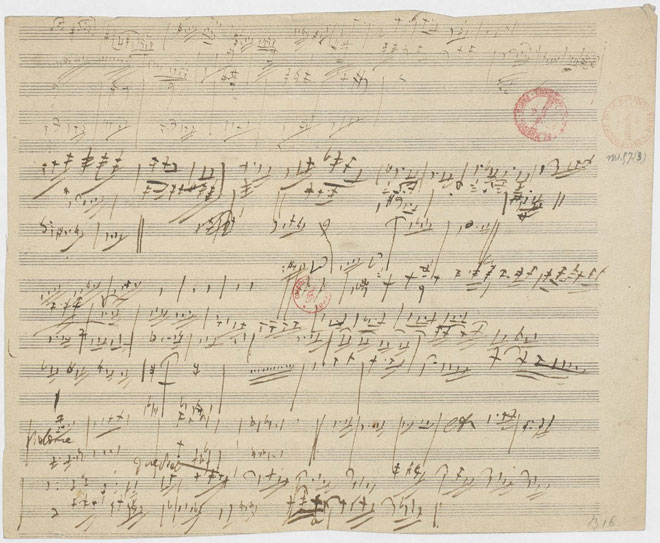
Even if the main part of the work was composed between 1822 and 1824, the Symphony n°9 is the fruit of a long maturation which lasted more than thirty years. Thirty years for the idea of a symphony with choir to progressively take hold in the mind of Beethoven. Thirty years during which the music and the text of the “Ode to Joy” will evolve in parallel, each one gradually taking shape over the course of Beethoven’s compositions, before finally being reunited in their last symphony.
Symphony No. 9 is exceptional on many levels: by its duration of course (this is Beethoven’s longest symphony), but also and above all by the introduction of voices in the Final. In addition, even if Beethoven keeps the four traditional movements of the symphonies of the time, he develops and amplifies them to the extreme, multiplying the surprises and the mixing of genres.
I. Allegro ma non troppo
Like most of the first movements of symphony, this allegro is in sonata form: it opposes two contrasting themes which are then developed and then re-exposed. But Beethoven takes care to bring some touches of originality. The introduction is already astonishing and provokes a feeling of expectation, mystery and doubt: during the first sixteen bars, only two notes, the A and the E, are played continuously. First very slowly, pianissimo, the orchestra gradually unfolds in a great crescendo culminating in the explosion of the first theme. Powerful, imposing and majestic, it is played by the whole orchestra in the fortissimo nuance, contrasting with the second theme which succeeds it, consisting of a multitude of varied patterns. After a fugato development of the two themes, then their re-exposure, the coda in its turn is a source of astonishment: exceptionally long (almost as long as the re-exposure), a surprising funeral march concludes the movement.
II. Molto vivace
Placed in the second position (and not in the third as is custom in the other Beethoven symphonies), this movement is of traditional scherzo form, but its length is unusual. The scherzo part begins immediately with a fugato exposing the theme in different voices, before it is played by the whole orchestra with a lot of timpani. Very energetic, lively and almost frenzied, this scherzo contrasts with a quieter and serene trio, to which the horn and oboe solos give a pastoral atmosphere that is reminiscent of Symphony No. 6.
III. Adagio molto e cantabile
Following the style of variations on two themes, this third movement is a real moment of peace and serenity. After the exposure of the two founding themes (the first theme being a very melodic adagio molto, then a second slightly more vivid, andante moderato), their variations sometimes accentuate sublime ornamental melodies and other times a different orchestration. The coda, surprising once again, has an unexpected joyous fanfare before the very last variation of the movement.
IV. Finale
This last movement is almost a work in its own right by its exceptional duration (it is as long as Symphony No. 8!) And by its architecture, which can be compared to that of a symphony in four movements. It mixes many musical genres: recitative form, variations, fugato, and even a Turkish march! And of course, it is in this movement that the long-awaited voices finally enter.
We can divide the Finale into four parts:
Orchestral introduction: Starting abruptly with a dreadful fanfare (the “terrorful fanfare” as Wagner dubbed it), this orchestral introduction plays a melody performed by the cellos and basses in the style of the recitative, interspersed with very short quotes from previous movements. The, the theme of the “Hymn to Joy” appears, gently and simply again on cellos and double basses in unison, before being varied. As the other strings (violas and violins) enter one after the other, the tension gradually increases until the music bursts out, triumphant, when the theme is played by the whole orchestra in the fortissimo nuance.
Sung variations: After the return of the fanfare, this second part develops according to the same scheme as the first: the melody in recitative style, sung this time, is followed by the enunciation of the theme of the “Hymn to Joy”, first by the baritone alone then resumed and varied in crescendo by the solo voices and the choir. A large interlude varies the theme in the style of a Turkish march with instrumental fugato, before the return of the hymn sung by the choir, grandiose and brilliant.
Andante and Adagio: In a slower, majestic, almost religious tempo, a new theme (sometimes called the theme of Brotherhood) appears here. It then mingles with the theme of “the Hymn to Joy” in a large choral fugato, in an energetic movement (allegro energico) which contrasts with the previous tempo.
Final development: Once again this is exceptionally long, like the rest of the symphony, this last section presents the two themes of the Finale (the Hymn to Joy and the theme of Fraternity) in various forms, before the coda itself appears. This closes the movement (and therefore the whole work) in an unleashed and dazzling prestissimo, exploding all the Joy of Schiller’s poem.
Tags: Beethoven, Symphony no.9


I can’t listen to this piece without jumping out of attic windows.
More of this please.
Everyone knows that Fürtwangler’s 1942 performance is the absolute best there is and ever could be!
I’m gonna need a dictionary or some musical education to decipher the article, but it’s a good effort, this music is supreme.
Agreed on F’s 1942 rendition.
Music stopped being good when it stopped being composed for courts and churches. Beethoven’s (& other early Romantics) ego-worshiping, Promethean quest to bring music to the masses is the missing link between Golden Age and the modern shitty art. If you want to blame someone for self-expression taking precedence over formalism, this is your guy.
More likely social changes. “We can educate the middle classes to appreciate good music!” Two centuries later: everything is hip-hop and pop country.
FAIL